Being in the DR produces an interesting cognitive state for me because, on the one hand, it is one of the few places in the world that I've visited outside certain places in the US (like Washington, DC, or Detroit, or Atlanta) where the majority of people share my complexion, are built like me, are mostly of African descent (Bahia and Rio are the others), and this puts me very much at ease, and sparks a feeling of recognition that I have not felt traveling other places, meaning I can utterly be myself and relax; and yet, because of the language and cultural differences, because I am so obviously not from there and know it and know the people there know it, I also feel like a visitor and an outsider. In terms of clothing, body size, how I move through the street, even facial physiognomy and grooming, most Dominicans now automatically assume I'm American; on our first few trips, people looked at my dreadlocks and would say "jamaicano" or call out Bob Marley's name (I get "Ras" and "Rastafari" all the time in New York and Chicago), to the extent that one man, like a mina bird, would scream out "No woman no cry" every time he saw me; but in the Colonial Zone, where we've stayed a few times now, the people I encounter increasingly assume the default of "American," and in some cases are still surprised when they hear me speaking Spanish (however slow and non-idiomatic it is). We've seen only a few Dominicans with dreadlocks--there was a Dominican-American on our plane once sporting them, I met a budding Rastafarian in Boca Chica, and spotted a few locked folks circulating around the Conde, so my hair above makes me stand out. On the other hand, in other places, like Santo Domingo's Gazcue neighborhood, I had people address me directly in Spanish without hesitation, and my assumption was that these Dominicans figured that perhaps I was a longterm non-Dominican resident, a local who'd taken up Rastafarianism, or a native who'd lived in the US or elsewhere in the Caribbean and adopted a non-Dominican style of self-presentation. Or maybe it didn't even go that deeply--but I did wonder. What are the markers for methods of identification, and identifying difference? What do they look for, what do I look for?

One of the issues that pops up in a hideous way on the message boards of a site like DR1 is race, and racism. (Sometimes the moderators will shut down threads if people start asking too many questions about race specifically.) While I've said that most of the Dominicans I came across in the DR were of obvious African ancestry, I did not say they were Black. According to various US definitions of Blackness, like the one-drop rule, the vast majority of Dominicans would be considered Black. (Most are as racially mixed, or more so, as most African-Americans, though here I think most people reject terms like "mulatto," which are historically problematic, even though other problematic terms like "biracial" have gained traction.) But without getting into a long disquisition about racial and ethnic formation in the US or DR--which would have to include the country's tumultuous history and relationship with colonial powers Spain and France; its tumultuous relationship with Hispaniola neighbor and sibling nation Haiti; the centuries of colonial and ruling class ideology, including the Spanish and criollo versions of white supremacy; Trujillo's slaughter of Haitians and dark-skinned Dominicans; Joaquín Balaguer's notion of Hispanidad; and what I will call, for lack of a better term, Indianism, of a vogue for Indian roots as a way of displacing the African ones--I cannot say that many of the Dominicans would automatically call themselves "Black," per se. Which is to say, they might not use terms like "negro" or "moreno" about themselves. I've read that the term "Indio" is common...and yet, despite the Black-effacing accounts that I've found online and in the official tourist guide that was in my bedside table, and the obvious championing of everything Taíno, what I saw in terms of the people themselves, how the people carried themselves, what was evident in numerous cultural traits (the food, the music, religious practices, etc.), was the indelible African imprint. (This is borne out in the histories by Cambeira, Domínguez, Rout, Sagás and Inoa, and others.) Yet the issue of "Blackness" remains touchy, whether under the guise of the economic and social situation of "Black" Haitians as a foreign presence in DR, or Blackness as a term of self-representation and designation or cultural performance in its various aspects in DR. What was evident among some of the younger people we came across, who'd adopted hiphop and reggaetón styles that celebrated a version of increasingly globalized, commodified, performative Blackness, or with a group like the self-labeled Los Negros (who sing R&B-inflected ballads and were on TV while we were there), was that the issues of Blackness, race and racism were much more complex than they're often presented. (The various local TV programs didn't hesitate to show brown and dark-brown-skinned people regularly, though some of the commercials were as a whitewashed as in Spanish-language American TV; why?)
When we were traveling to Bayahibe on our way to Isla Saona, our tourguide, John-Paul (Jean-Paul?), without prompting, pointed out to our bus full of Europeans (there was another Black American family with us) that in San Pedro de Macorís, where "Sammy Sosa," "Alfonso Soriano," and numerous other famous major league baseball players were from, so many "Haitians" had immigrated there and had mixed with the English-speaking immigrants (some of the earliest ones to San Pedro came from the US, while later waves came from other Caribbean islands like Tortola), that the result was a predominantly "Black" population. He actually used the English word; I immediately thought to myself, so what do you consider yourself? (He could easily have been mistaken for a Black American.) I also wondered who this bit of information was for? Were Europeans usually curious about the Black population? Was he saying that Sosa and Soriano were "Black," but people from other places were not? Was he saying that they were also part Haitian-part West Indian, and what sort of racial-ethnic construction was he devising in terms of San Pedro de Macorís? Would Sammy Sosa consider himself "Black"? (Jacques Chirac, France's corrupt right-wing president, in his usual outrageous hauteur, recently commented that Haiti and DR should rejoin, since both consisted predominantly of Black and mixed people. Either he is more ignorant than anyone believed, or he knew that this comment was sure to set Dominicans off for years to come.)
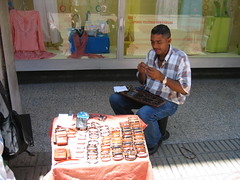
Thinking of John-Paul's comments made me think of our very first trip, when we were racing around the Colonial Zone with another guide (his name escapes me). He made a point of showing us everything to do with Columbus, the Catedral Primada Basilica (the first RC cathedral in the Americas), Taíno symbol-covered tchotchkes, and so on. After a bit of this, I finally had to ask, "What about the African history?" or something to that effect. Whereupon he replied, "We're all Black here,"or something very close to this, and quickly went on to the next topic. When we happened upon a little gallery run by two Haitian men that was full of Haitian art, and I asked them to see a vèvè, which they kept hidden behind the canvases, the guide basically fled the room. That was a bit too much "Blackness" for him, I think. At any rate, race remains a complex issue, which did not come up at all--and on one level, why would it have? Would I be discussing race in Barbados? In Jamaica? In Aruba?--even as its centrality to DR's social relations was constantly on view. (I'll leave the question of Haiti and Haitians for another post.)
Without doubt, I think I've been treated as well (maybe better?) in the DR as in any other place I've other visited. But then, as I wrote in a prior post, I think, outside of the US, I've never encountered the blatant and constant racism I do just living every day in this, my native country. Never. Not in Canada, not in any European country (save one) I've visited, not in Mexico, not in Brazil. Whatever people have felt about Blacks--and racism is alive in well in all these countries, without a doubt--not once have I experienced what some friends have, perhaps in part because I'm usually identifiably American, identifiably a tourist, and a man (gender-related bias plays into racist attitudes). In fact, the only overtly racist incident I experienced occurred in Lisbon, Portugal, in 1990, when I was mistaken for an African (and there were hundreds--thousands?--of Africans milling about the main squares of that city), which was sort of a childhood fantasy of being a different kind of Black person (an African, no less!) playing out in the most negative way. That experience definitely was not what I think any of the teachers in African dancing or my Black drawing classes could have prepared me for. The DR is also the only place where men I've never met have called me "beautiful" (in English, not Spanish) to my face, on the street, no less, even if one was obviously a hustling scam artist and the other was lit up on pocket bottle of rum. The drunk actually repeated it, for emphasis, and didn't ask for money, either....
Spanish, which I'm glad I taught myself years ago, is utterly indispensible in the DR, especially for traveling around the capital city and to other points in the country if you don't have an English-speaking guide. Outside of the people at the hotel desk, the various Americans we know or met, and many of the Haitians I chatted with, most Dominicans we encountered spoke only minimal to no English. This was the case in Santo Domingo, in Samaná, in Boca Chica, in San Francisco de Macorís, in Bayahibe, pretty much everywhere we traveled. Occasionally some Dominicans made a point of speaking English, but that was rare (though if they'd lived in the US they were often fluent, and we met a few kids who were on vacation or adults who were back living in the DR after years in the US). I'm also glad that rather than learning Castilian (or as I was always told, "proper") Spanish, what I've managed to acquire is a garbled but useful Caribbean-Mexican idiom, which probably wouldn't be intelligible in Spain, but it works in DR and among Spanish-speakers in the US.
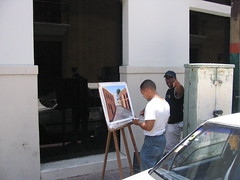
I always enjoy coming across fellow Americans outside the country, but the DR is the only place I've been where many of them are Black--and lgbt/sgl. On our trips to Brazil, of course, we have come across a number of Black Americans; when we went to Bahia, I spotted poet and former teacher Sonia Sanchez and scholar and poet Rachel Harding while we were making our connection in the São Paulo airport, and later, through a bit a serendipity, ran into Sonia's son on the beach in Rio. On another visit, when traveling down to Rio we noticed a number of straight Black American men on our flight, and once there we met other Black Americans (male and female) who were recreating and taking in the cidade maravilhosa. But the DR is perhaps the only place I've been where most of the Americans we've met are Black, and a sizable number also happen to be lgbt/sgl as well. In Santo Domingo, Black gay Americans have actually begun to develop a business infrastructure; first and foremost there's Anthony Montgomery, who founded and runs the Monaga Corporation, a multiservice organization that includes an apartment suite and rentals, tours, and much more. We've also met David Lee, who runs the Sports Bar, a great casual nightspot, and Mario Sessions, a graphic designer and photographer who organizes DR events. In addition we've encountered a number of Black gay/sgl American tourists who, like friends of ours over the years, have visited and fallen in love with DR and its people.
I often wonder what it would be like to live in a foreign country for an extended period of time. When I was in college I knew a few people who could afford to take time off and go travel; most went to Europe or Asia (China, Japan), to do research and experience the cultures they were studying in person. Since then I've known a number of writers and artists who've done so, usually in Europe, though I know of several poets who've spent time in Bahia, and as is clear from her blog, Soucouyant was in South Africa for several months. When I worked at MIT, I used to prepare visa applications for foreign visitors, and got to know scholars from Israel, France, Italy, South Korea, and Brazil who were spending six months to a year in Boston. The longest I've ever lived away from what I'd consider my primary home (or homes) was during a writing residency in Saratoga Springs, which I think lasted two weeks or so (I had to get back for the purposes of work). C and I both have wondered what it would be like to live in DR, so maybe we'll have the opportunity to do so eventually. I realized that I could live there (as I could in other places we've visited), but that my perspective really would change if were there for an extended period as opposed to visiting as a tourist. Not have recourse to English, dealing with the electrical problems, the cultural and societal differences, including the legal system, and being cut off from the familiarity of US, among other things, would pose serious challenges.
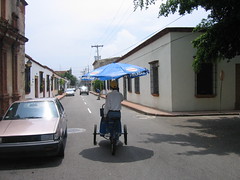
The economic crisis and rising poverty in the DR become more evident every time we visit. I usually keep up with DR news via the DR1 site, and through my reading am a little familiar with the political situation in the country. In 2004, Dominicans re-elected as their president Leonel Fernández Reyna (Leonel), the New York-raised economist and leader of the PLD party, who had become president in 1996 by joining with PRD leader and former dictator Joaquín Balaguer to defeat RPD leader José Francisco Peña Gómez, the former mayor of Santo Domingo and a Dominican of Haitian ancestry whom Balaguer and others in the political ruling class were determined to keep out of office. During his first term, Fernández Reyna pursued neoliberal economic policies, including selling off the electrical grid and privatizing various aspects of the economy. His four years in office coincided with the US (and world) economic boom under moderate-conservative Democrat Bill Clinton, and the Dominican economy expanded. In 2000, Leonel couldn't run again because of Dominican constitutional provisions, and Hipólito Mejia, from Peña Gómez's party, was elected president. In four years the Dominican economy (like the US economy) tanked; a spectactular private bank collapse, which Mejía allegedly used $2 billion from the Dominican treasury to cover, only made the economic situation worse. Leonel has placed improving the Dominican economy and creating jobs at the forefront of his presidency (and it is remarkable, I have to say, to see the president of a country on television freely engaging in probing conversations with scholars, government officials and business leaders about contemporary societal issues is thrilling, yet talk only goes so far), but rising oil prices, limited natural resources, low prices for Dominican commodities, waxing inflation, a lack of investment capital, longstanding structural and infrastructure problems, a steadily increasing populace (both through natural growth and immigration from Haiti and other countries, like Cuba), international fiscal demands, and the worsening situation in neighboring Haiti, which continues to send thousands of people to DR in search of work, have made it extremely difficult for Leonel to pull off a quick turnaround. On top of this, the basic crisis in electrical service (there are daily blackouts, and three times within the last week the entire country has experienced a blackout) not only is disadvantaging DR's businesses in general, but especially one of the country's growing sectors, tourism, compared to many of its smaller Caribbean competitors. The desperation among many people was evident to me; in Santo Domingo, I noticed more street children, more adults begging and begging aggressively, and more intensity in the usual hustles we've encountered in the past. The physical state of some buildings in Santo Domingo's colonial zone seems to have worsened as well, though I also noted a lot of renovation, since DR remains a bargain investment option compared to other tourist-target countries. The release-valve option of coming to the US has become more difficult since 9/11; not only are US authorities shipping Dominicans back from nearby Puerto Rico, but it's harder for Dominicans to get visas to travel to the US.
After our first trip to DR, when we stayed in Boca Chica, what immediately struck me was how overt the heterosexual prostitution in that resort were; as we pulled up to our first hotel, a European man and Dominican woman were engaged in a financial transaction right in the driveway. Subsequent trips have impressed upon me that the sex trade in all its forms is thriving there (though less so, it seemed, in Samaná), in no small part because of the dire economic situation the majority of Dominicans are facing. While I support people's right to earn money in whatever ways they can, I find exploitation of any sort deeply disturbing. For many women and men in DR, as in Cuba, Brazil, Thailand, and other countries, the sex trade is one of the surest ways to earn money and put food on the table...and yet rationalizing this does dispel the sense that things would be better if people had more employment options. (In wealthy countries, prostitution exists, and might be an option of choice--but there is a difference between having options and having none.) Sorting out sex-for-pay and exploitation, however, is not so easy, which makes discussing it a fraught subject to discuss (and some people, like French author Michel Houellebecq, actually celebrate it as an option for the economically marginal and oppressed outside Europe, and for the sexually rejected among Europeans.) A separate but related issue involves the sexual exploitation of minors, which also deeply troubles me. Recently a friend noted that he would not want to travel to countries where sex tourism is so evident, and I had to remind him that he would be disqualifying most of the countries across the globe, especially outside Europe (where the sex trade flourishes even in some of the wealthiest societies on earth), but I added that prostitution and sex-for-sale exist the US as well. (One of Jersey City's prime prostitution strips, where poor female addicts congregate, was featured just a few years ago on the nationally syndicated Fox show Cops, while documentaries on prostitution in New York have also appeared more than once on TV in the last few years.) Of course that doesn't make exploitation anywhere any better, but I try to keep in mind that the issue is complex and not so easily reducible to moralistic pronouncements and slogans.
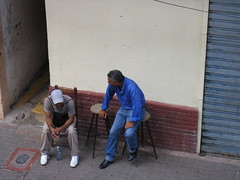
Just as I ventured to comment on race, I also will say a little about (homo)sexuality. A while ago I read an interesting article, via Monaga's site, on homosexuality in DR. One of the arguments in that piece was that DR was a conservative, macho, class-stratified society, and that while there was a nascent gay scene in Santo Domingo and a US-European style "gay" consciousness was developing there, historical traditions, the conservatism of the culture, the influence of the Roman Catholic Church, different views on sexuality and sexual commerce, and class and economic issues were all strongly shaping its developing, making it quite different than in some other Caribbean or Latin American countries. As in Haiti, and unlike in most Anglophone and some other Hispanophone countries, homosexual sex was never criminalized because of the adoption of the Napoleonic code (which decriminalized same-sexual relations in France at the turn of the 19th century). Lack of criminalization, however, doesn't mean acceptance, and I think it would be fair to say that overt displays of homosexuality, at least as we might see in the US, would not be acceptable in most parts of DR, especially in rural areas. But acceptance is also a different issue from same-sexual practice. I've argued before on here that equating same-sexual practices with gay orientation, with "gay" self-identification, and with what you might call gay social performance, is problematic; some of the Dominican men I spoke with that I knew were MSMs reinforced this difference. Many had children, some were married. How applicable would Euro-Americans labels be for these men, even if they'd come into contact with the social constructs behind them? Maybe, maybe not. In Santo Domingo there were also men who appeared to be more openly homosexual, in their public performance. There seemed to be a social space open to them; since I don't live there I don't know, but I did wonder what life was like for them. What about in smaller cities and the countryside? According to the article, things were different, and perhaps more difficult for middle-class gays. (And probably easier for wealthy and rich gays.) I was therefore interested in the social spaces created by the American entrepreneurs, and how this was shaping views of sexuality and self-identification, and social relations more broadly. In terms of the social norms, heteronormativity was, unsurprisingly, quite strong: people constantly were assuming that C. and I were seeking women. As the Black lgbt tourist stream grows, will people's perceptions of the tourists change? Unfortunately, I didn't meet any self-identified lesbians, though I imagine there is a lesbian scene, not only in Santo Domingo, but in other parts of the country as well.
Back in January 2003, I saw Andrea Robbins's and Max Becher's exhibit The Transportation of Place at the Museum of Contemporary Photography in Chicago. One of Robbins's and Becher's foci was the "Americans of Samaná." As the press release described this aspect of the exhibit:
The series The Americans of Samaná (1998 – 2001) documents the descendants of freed African American slaves who traveled to the Dominican Republic in 1824 in a scheme initiated and financed by President Pierre Boyer of Haiti, with the cooperation of the American Colonization Society. Today about 8,000 descendants of the original group speak an American English from 1824 in a Spanish-speaking country and live in linguistic and religious isolation-the "Americanos" are protestant, while most other Dominicans are Catholic.This wasn't the first time I'd heard about Samaná (which is where Napoleon's military landed in its final attempt to reconquer Haiti and which was nearly purchased by the US in the 19th century), though. Almost a decade ago, I worked with a Dominican guy, Frank C., whose family came from Samaná, and though he had a Spanish last name, he'd told me a similar story of the American links there. I also known of a scholar, José Vigo, who served as an intellectual mentor to a close friend, and who'd been studying the Americanos in Samaná before he died of AIDS in the late 1980s. In the city of Samaná and in the Samaná resort town of las Galeras, where we stayed during a previous visit, we actually looked for some of these Americanos, whom I imagined would, as the exhibit proclaimed, would somehow stand out. On the bus trip back from the northern province, I asked a young White American Peace Corps worker if he'd come across any of the English speakers in the Samaná countryside (el campo), and he said he hadn't. Though we did meet some natives of Samaná and asked around, we had no luck in finding the Americanos; flipping through the Samaná phone directory, however, I did see a number of English names (Bell, Green, Lee, etc.), which provided some evidence that some of the Americanos (and subsequent waves of English-speaking immigrants from the Caribbean, known as cocolos) actually are there, somewhere. (Current Detroit Tigers pitcher Fernando Rodney is from there). I actually have been writing a story that involves this particular aspect of African-American and Dominican history. At some future point, I hope to return to Samaná and meet some of the Americanos in person. Perhaps Samaná College, once it's off the ground, may provide the means for doing so.
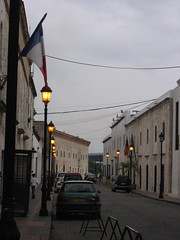
I'll end by saying that I probably have bought enough cigars to last me a year (since I rarely smoke them) and my favorite Dominican dish remains pulpa al ajillo (octopus in garlic). Sancocho dominicano (a kind of pot au feu), pollo dominicano, and all of the sopas de pescado (fish soup) are also high on my list. All dispelled whatever lingering desires I may have had for American cuisine--and in any case, fried chicken, spaghetti, pizza, and hamburguesas, sin y on queso, were available at many restaurants, had I wanted them. But I didn't....









amazing post, john....Im trying to formulate a response right now..
ReplyDeleteRyan, mira, thanks for responding!
ReplyDeleteHaving reading that entry all I can say is WOW!!!! It is so comprehensive and covers so much about the country, again, WOW! Keep up the good work.
ReplyDeleteAnthony
Anthony, thanks for reading and commenting, and for being you!
ReplyDeleteRafael, I appreciate your comments a lot. I did not comment about the racism directly since I've posted about that before and will devote another entry to it down the road, but you're quite right that the overt racial animus against Haitians is quite apparent, and is interwoven into Dominican culture and public discourse. The thing I find fascinating, of course, is that this is always attributed to the Haitian occupation (1824-1844), when the reality is that other nations have occupied DR as well, including the US, yet it is precisely because of the longstanding white supremacy, racism, and eurocentric ideology that were passed down by Spain (and France, and the US), that has been repeatedly stirred up in Dominican history, that these attitudes persist. The fascinating thing to me about race and racism in DR is how Dominicans themselves negotiate it; most Black Americans setting foot down there would probably venture to say, after observing Dominican life, that these are obviously Black people, that their culture has analogues throughout the Black Diaspora in the Americas. Dominicans also appear to recognize this, but it's like "Blackness" is kept on the DL. But then Black people all over the Americas suffer from various forms of race sickness; we live with racism and it does its number, whether we're talking about in Alabama, in Puerto Rico, in Brazil, in Colombia, in Mexico.... Again, Rafael, thanks for your reply!
ReplyDelete